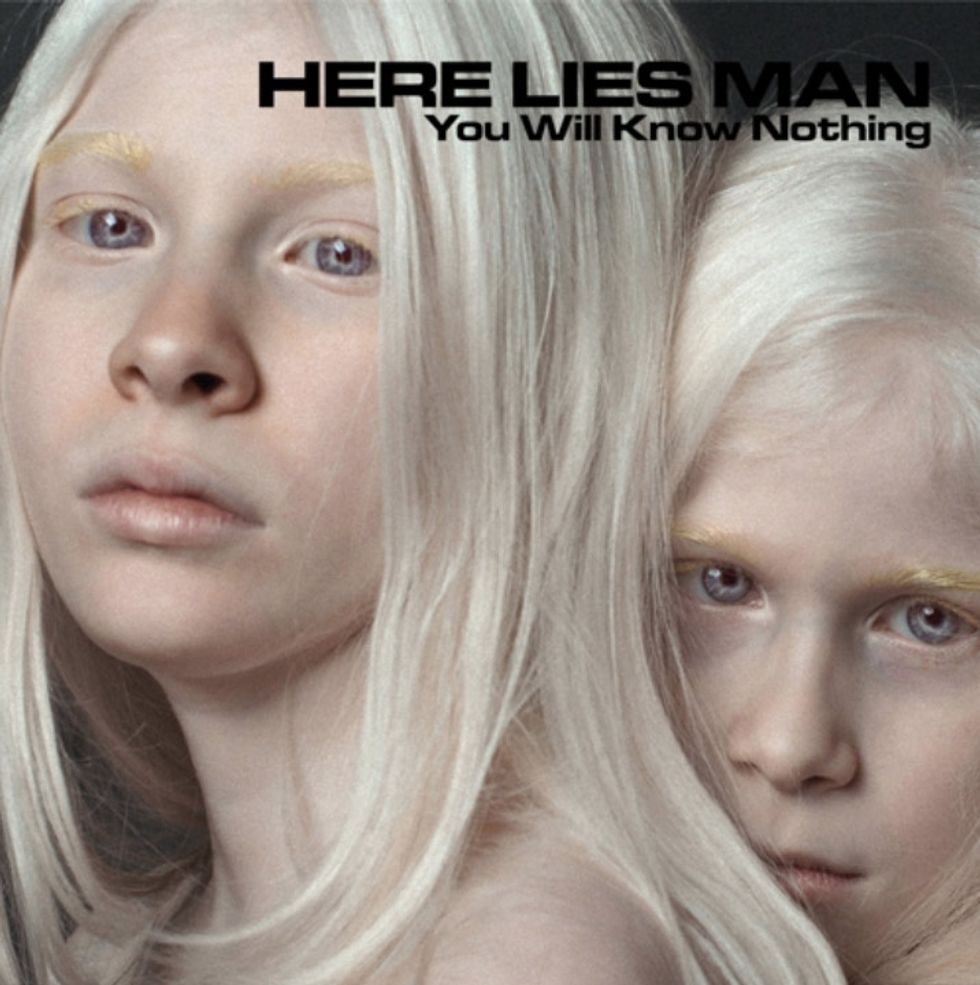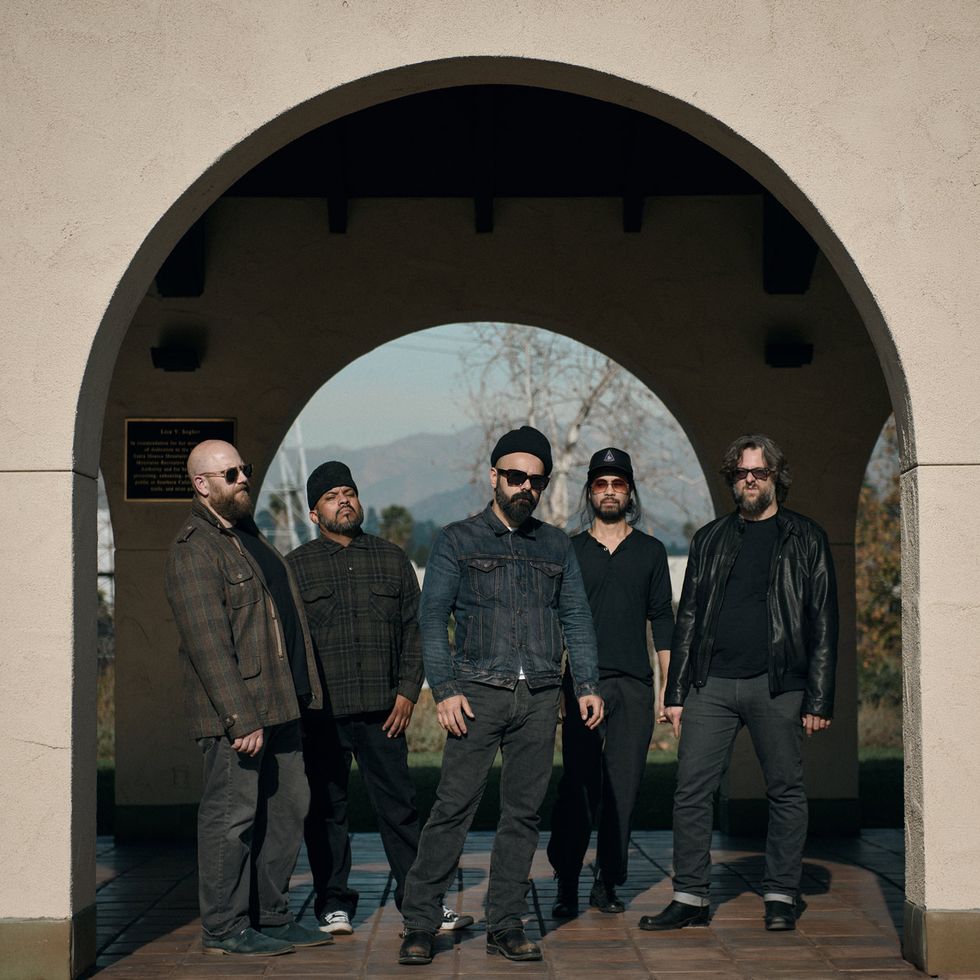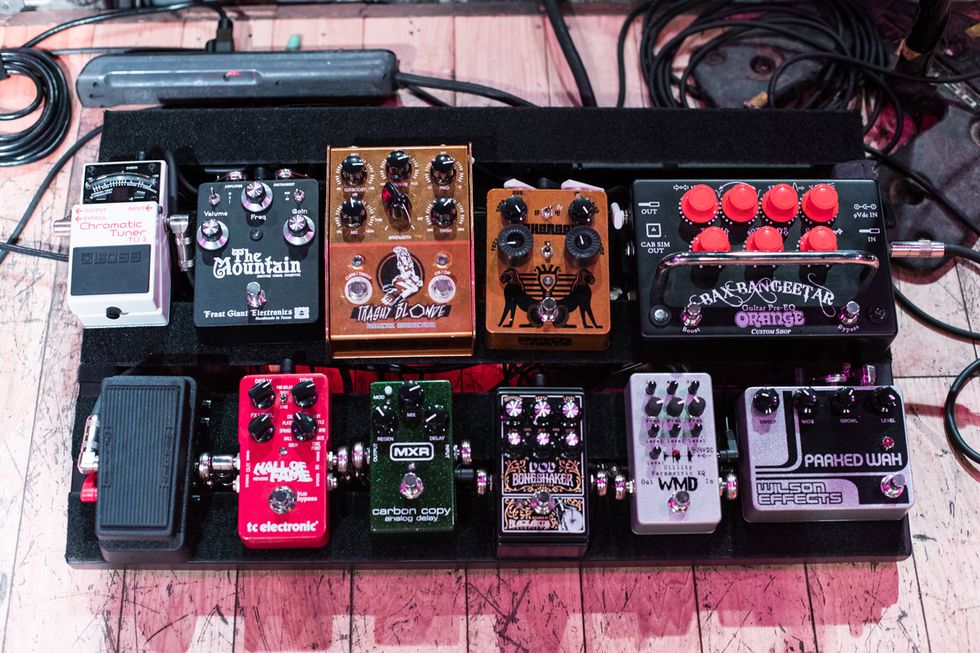What do you get when you cross the heavy riffs of Black Sabbath with the afrobeat rhythms of Fela Kuti?
A. A mess.
B. A neurotic giraffe.
C. The band Here Lies Man.
If you answered “C,” you’re right. Here Lies Man, the brainchild of Antibalas guitarist Marcos Garcia, is a surprisingly natural synthesis of afrobeat and heavy metal.
Incongruous?
Maybe, but—like chocolate and peanut butter—those two seemingly disparate styles naturally jell in Garcia’s hands.
Garcia stumbled upon the idea in the studio. “I was noodling around, shedding a Fela Kuti song called ‘Yellow Fever,’” he says. “I was playing the tenor guitar part—basically, the single note counterpoint to the bass line—and all of a sudden I imagined what it would sound like with fuzz. I thought, ‘Man, Tony Iommi could have played this,’ and ding! The lightbulb went off.”
But Garcia was busy with the Fela-inspired Antibalas and his electronic afrobeat project, Chico Mann, and it took another 10 years before he teamed up with drummer Geoff Mann and launched Here Lies Man. “Geoff was the missing link that allowed me to finally develop the idea,” he says. “Just having that swing and having the rock ’n’ roll references, but also knowing how afrobeat works rhythmically. There’s a musical vocabulary we’re employing that we both draw from, and there needs to be a fluency for each of us. Geoff just got it. It was great. I remember saying, ‘I feel like you’re reading my mind.’ We were moving together because we were both fluent in this vocabulary.”
That vocabulary—the larger-than-life riffs of early metal combined with afrobeat’s clave-centric approach to groove—are the foundation of Here Lies Man’s sound. It’s heavy, but it isn’t plodding or monotonous, and it induces the same transportive, mantra-like state of the best afrobeat.
“I feel like scientists need to do a study about this,” Garcia says regarding his music’s trance-like nature. “Put some sensors on the brain and read what happens to the brainwave activity. I am convinced there is something going on there.”
But grooves and spirituality aside, Garcia is also a bona fide gear junkie, and Here Lies Man’s recent release, You Will Know Nothing, is a testament to his never-ending tone quest. The album drips with fuzz, which he conjures using myriad stompboxes and an enviable collection of vintage Ampeg V-4s. That gear, plus a small army of slightly modded Les Pauls, fills Garcia’s toolbox.
We discussed those tools with Garcia, as well as his intimate knowledge of clave and groove, the making of You Will Know Nothing, and his thoughts about rock ’n’ roll’s African roots.
Your band is a lot smaller than a typical afrobeat ensemble. How do you work out your arrangements so you’re covering all the parts?
One of the main things, in the smaller format, is to distill the musical ideas into the simplest forms and use that as the jumping-off point. In afrobeat, you have all these layers that are usually two-bar figures—sometimes four-bar figures—and they create this much more dense arrangement. My concept is to boil that down to what is really the most compelling part and then build off of that. At most, there will be three layers if the bass, guitar, and keyboards are all playing counterpoint. These are melodic layers. I am not talking about the drums. The other part is to let the drums shine. Geoff has so much to say musically, even if we do break into a three-part counterpoint, he is still driving the whole thing.
Plus, the timbre of the distorted guitar is much thicker.
Exactly. When the guitar is fuzzed out it takes up a lot more space than it would in traditional afrobeat.

Job one for tracking the new album was cutting guitar and drum tracks together, live. Then overdubbing began. “Once I get the interplay with Geoff happening and we have that captured, I can track to that,” says Garcia.
How did you develop your approach to clave, groove, and polyrhythms?
I grew up with Cuban music. My dad was a record producer and I grew up with Latin music. To a certain extent, when you grow up around it, you absorb it. But it wasn’t until I was in my late teens that I really started getting into Latin jazz and Afro-Cuban music. Once you really digest it, it becomes part of you. I think that what you don’t hear a lot of in rock ’n’ roll is music that follows the clave. You have different bands that play Spanish rock or some kind of Latin rock, but rock ’n’ roll is typically straight ahead. Sometimes you can find the clave, but for me, the clave is the starting point. There are always going to be two sides of a phrase. It’s like a call side and a response side. At the simplest level, that’s really what it is. Instead of playing straight eighth-notes or quarter-notes chugging away straight through, every tune runs on a circle. There’s always going to be two sides to that circle and you can flip which side you’re accenting.
Meaning that every phrase has a second phrase that answers it?
Every phrase is composed of two parts. There’s the front side and there is the back side, and you can accent one or the other. The most famous clave that everyone knows is [Bo Diddley’s] “Hey! Bo Diddley.” There is the three side and there is the two side. You can focus on either side. It depends on what you want to emphasize on any one part of the song. The fact that it’s binary allows for all this extra syncopation that can cross over the clave.
Is it syncopation or do you do polyrhythms, like two against three or three against four?
No. Typically, not so much. There are the permutations of the clave. You get into some interesting polyrhythmic-feeling rhythms when you start crossing over the clave. Like dotted eighth-notes or triplets cross over to the other side of the clave and you won’t realign until you’ve passed two cycles of the clave. That’s where you get more complex and closer to the Afro-Cuban innovation on African music.
But when you’re playing, I assume it’s intuitive.
Yeah. It is funny to talk about it because it really is something that you just you feel. It is never something that I am trying to premeditate or think too much about. Something about the clave, which is the most wonderful thing about it, is that it has a trance-inducing effect on the human mind. The repetition of rhythm will induce different states of mind—brainwave activity, I think—and when you really give yourself in to it, it becomes easier to hear the permutations of the clave and how they cross over.
Is that why afrobeat songs are usually so long?
Yeah. It is meant to induce this other state. In that state you are more receptive to whatever the message is. In Fela’s music, the message was resistance and political in nature. Most Western people tend not to have the attention span for that amount of time when listening to music. I don’t necessarily exclude myself from that, at times. So for me, taking that and making it something that’s accessible to everyone is preferable. Our recorded tunes tend to last three or four minutes, and then live they can stretch out. There is plenty of room to stretch out onstage and improvise, but when it comes to the recordings, I want it to be accessible to people.
The seeds for Here Lies Man were planted a decade ago, but the group jelled in 2017 when Garcia partnered with drummer Geoff Mann (far left). “There is a musical vocabulary we’re employing that we both draw from,” Garcia says. “Geoff just got it.” Photo by Reza Bahrami
Talk about how you use riffs, as opposed to chords, as the rhythm guitar part.
I don’t really play chords in Here Lies Man. I let the keyboards do that. What I do is mostly riffs and power chords because it is just so visceral and direct. That’s the power of rock ’n’ roll. The power of the riff is that it is a short figure that captures your imagination. In Here Lies Man, it is all about the riff.
That’s very different from Antibalas, where you’re playing chords and single-note lines.
In an Antibalas context, the guitars are creating this harmonic web that supports the horns and the keyboards and the vocals. We don’t really stop playing, unless it’s part of the arrangement. But the same thing happens when you’re playing as when you’re listening: You go into this other place. But you’re not on autopilot—you’re completely aware.
There are no solos on the new Here Lies Man album.
Like I was saying, for the recordings, it is to get to the meat. Soloing is more for live. I want the recordings to be a distillation—the simple concept, not the elaborated concept. That allows the music to be directly assessable to the listener. I also don’t want to commit to a solo concept on a recording that I am going to want to replicate every night. I want there to be the possibility that on any given night, there is going to be something new and something to discover in the performance of the song.
Do you record live as a band or do you do it piecemeal?
It’ll be Guitar 1 and the drums. Guitar 1 because there are a few layers of guitars. I want to get the most impactful, flying-by-the-seat-of-your-pants performance from Geoff. There’s the guitar recorded concurrently with him, and then we’ll start overdubbing on top of that. Once I get the interplay with Geoff happening and we have that captured, then I can track to that.
One of the key distortion pedals in Garcia’s live rig is his Orange Bax Bangeetar, which, like his beloved vintage Ampeg amps, incorporates a Baxandall EQ circuit. Photo by Sandy Carson
Do you redo that first guitar part?
No. Usually it stays and that becomes the center guitar. I have a whole mental map for how I want things panned and how I want them to feel psychoacoustically. Especially with the keyboards. The keyboards tend to be double-tracked, hard-panned, and then detuned from each other because it creates this psychoacoustic effect when you’re listening with headphones. Some other things happen with the guitar. Bass is a little different, because that has to be more straight up, in the middle, and holding everything down.
Do you play the bass on the new album?
On our two albums, I played the bass. We found JP [Maramba] after I had already recorded this album. It is tough to find people who are equally as comfortable in rock ’n’ roll as they are in afrobeat. That’s a crazy search.
What do you use for amps?
On the album I’m mostly using an Ampeg V-4 and a Fender 75. But I have definitely gone down the amp rabbit hole trying out different amps. What I love about the V-4 is the tone stack and the mid-shift capabilities. I started looking for amps like that. V-4s are expensive to repair. At one point, I had five—either a VT-22 or a V-4—and they all shit the bed at the same time. The repair bill for that was astronomical.

Guitars
Gibson Les Paul Custom with 490R (neck) and 498T (bridge) pickups
Gibson SG with a DiMarzio DP100 Super Distortion (neck) and a Bare Knuckle Juggernaut (bridge)
Ibanez PF-400 with Bare Knuckle Juggernaut pickups
Orville By Gibson Les Paul with 490R (neck) and 498T (bridge) pickups
Amps
Ampeg V-4
Fender 75
Orange Rockerverb 50 MkIII
Traynor YRM
Peavey Standard
Blackstar HT Stage 100
Effects
Black Arts Toneworks Pharaoh fuzz/overdrive
EarthQuaker Cloven Hoof Reaper dual fuzz
ZVEX Mastotron silicon fuzz
EarthQuaker Fuzz Master General
SolidGoldFX 76 octave fuzz
Guyatone the Fuzz TZ2
Dunlop Cry Baby 535Q Multi-Wah
Wilson Effects Parked Wah
Orange Bax Bangeetar Pre-EQ
MXR Ten Band EQ
Subdecay Prometheus DLX Deluxe Resonant Filter
Eventide Space reverb
Eventide TimeFactor delay
Chase Bliss Warped Vinyl MkII Analog Vibrato/Chorus
Boss RE-20 Space Echo
Iron Ether Xerograph Deluxe low-pass filter
Way Huge Swollen Pickle fuzz
EarthQuaker Terminal fuzz
Maxon FF10 Fuzz Elements Fire
MXR Carbon Copy
Iron Ether Oxide fuzz
Boss TU-2 Tuner
Strings and Picks
D’Addario ECG25 Chromes Flatwound (.012–.052)
Clayton bass picks 1.26 mm or 1.52 mm
My quest has been to find something with a Baxandall EQ—maybe something with power scaling or attenuation capabilities, so I can get the power tubes cooking but not offend everyone with the volume. Although, I feel that’s inevitable. I talked to the Ampeg people at NAMM. I said, “You guys really need to put out a V-4.” I know they put out the V-4B, but it’s not the same. I was trying to convince them that there is a market. I’m not the only one who wants those amps as in-production models. There’s no way I am the only person.
You don’t use that with Antibalas.
Nooo ... I would not be in Antibalas if I did that. For that sound—that chicken-pickin’ sound, which is my tone in that band—I use a Fender Twin with maybe a treble boost to get the extra clickety-clack, twangy-pluck sound. The Fender Twin is something clean that still has tube warmth.
Do you get your fuzz from pedals, the amp, or both?
The pedals, mostly, because unless you have the master volume model or a master volume mod on the V-4, you can’t get that thing to break up, which is the beauty of it. I do have some of the master volume ones and those do break up. They’re just creamy and lush and sound wonderful. But for the album, I definitely went down the fuzz rabbit hole and tried a bunch of different pedals. The whole thing is layering the guitars with different fuzz pedals, different pickup combinations, and different guitars, just to get distinctive tonalities happening and create a thicker, lusher general tone. That was the M.O. behind this record.
What do you do for reverb?
It depends on the amp—if it has it. Some amps don’t. When I was on tour and using the Orange Rockerverb, the reverb on that sounds great and I didn’t have to use a pedal.
In the studio, do you add the reverb in post-production or record with it on?
There are no time-based effects added in post. Never. I want to make something that has vibe and character and doesn’t sound polished and clean. I find that even if you are using some digital pedal, once it’s coming out of a speaker and you are recording that through preamps and analog gear, it gains more and more character. As it loses that pristine fidelity, it starts getting more and more character. I am not so much interested in getting pristine high fidelity. I am more interested in getting textures and colorations and things that generate a mood and give you a visceral feeling. I am more interested in that than hi-fi.
Talk about rock ’n’ roll’s African roots.
I think we’ve gotten to the point in history, as a culture, where people forget the African roots of rock ’n’ roll. It’s been lost over time. But they are genetically connected and continue to be so—just the awareness is gone.
There are many incredible rock bands coming out of West Africa now, like Songhoy Blues and Tal National.
I just heard Tal National and they sound amazing. That’s what I am saying: There is actually a really long history and it’s just an awareness thing. I’m in the music business and I hear about all kinds of stuff, so the fact that they’ve been around for a long time and I never heard them was like, “Wow, you can still be surprised this day and age.” Just when you start getting jaded enough, as in, “I’ve heard it all,” something new comes along. I thought, “Yes.”
Marcos Garcia’s fondness for fuzz is evident in this studio performance at KUCI radio. And you’ll also hear his Wilson Effects Parked Wah, starting at about the 2:00 mark, as he works a hypnotic riff on his Les Paul Custom.
Essential Afrobeat
Want to learn more about the blend of African and Western sounds that its main architect, Fela Kuti, named afrobeat? Marcos Garcia has some suggestions.Fela Kuti, Gentleman
“If someone has never heard afrobeat before, Gentleman is a good introduction,” Garcia says. “That was Fela at his height—Gentleman or Zombie.” Recorded in 1973, Gentleman features 15-minute songs that take their time. On the title track, for example, the band plays for eight-plus minutes before the vocal enters. The album features Kuti’s large ensemble, Africa 70.
Fela Ransome-Kuti, the Africa 70, and Ginger Baker, Live!
“Ginger Baker was onto some cool shit back in the day that very few people were hip to,” Garcia says. “Is it the best Fela record? No. But it’s cool to listen to Ginger Baker getting up in the mix and embracing this music.”
The Funkees, “Dancing Time”
The title track from a compilation of the Funkees, “Dancing Time” represents the East Nigerian band’s mid-’70s output. “You start to hear afrobeat and rock happening together,” says Garcia.
Orchestre Poly Rythmo de Cotonou, “Se Ba Ho”
This group was an afrobeat band from Benin. Their catalog is available on the Analog Africa label, which is built from the efforts of crate-digger Samy Ben Redjeb, who reissues lost African classics.
The Daktaris, Soul Explosion
The Daktaris were a faux-Nigerian band from Brooklyn, but their sole release, Soul Explosion, oozed authentic afrobeat mojo. The Daktaris never issued a follow-up, although some of their members went on to form Antibalas. “The raw spirit of Soul Explosion informed how Antibalas approached its early compositions,” says Garcia.
Antibalas Afrobeat Orchestra, Liberation Afro Beat, Vol. 1
“It was one of the first American afrobeat band recordings,” Garcia says. “It inspired bands like the Budos and countless others that sprang up around the U.S. and Europe.”













![Rig Rundown: Russian Circles’ Mike Sullivan [2025]](https://www.premierguitar.com/media-library/youtube.jpg?id=62303631&width=1245&height=700&quality=70&coordinates=0%2C0%2C0%2C0)













![Rig Rundown: AFI [2025]](https://www.premierguitar.com/media-library/youtube.jpg?id=62064741&width=1245&height=700&quality=70&coordinates=0%2C0%2C0%2C0)




















 Zach loves his Sovtek Mig 60 head, which he plays through a cab he built himself at a pipe-organ shop in Denver. Every glue joint is lined with thin leather for maximum air tightness, and it’s stocked with Celestion G12M Greenback speakers.
Zach loves his Sovtek Mig 60 head, which he plays through a cab he built himself at a pipe-organ shop in Denver. Every glue joint is lined with thin leather for maximum air tightness, and it’s stocked with Celestion G12M Greenback speakers.











